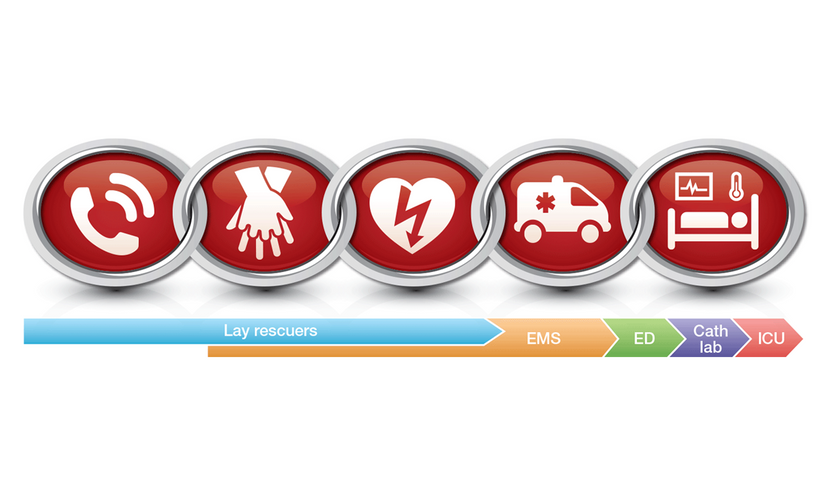Understanding The Chain of Survival

The Chain Of Survival
Developed in 1991, the American Heart Association "Chain of Survival" is a series of interventions which, when implemented in a timely manner, can greatly increase the potential for survival of Sudden Cardiac Arrest. Since it's inception, the "Chain of Survival" has gone through several iterations. Currently, there two main chains based on whether the arrest occurs outside the hospital or within. The most comprehensive version is the Out-of-Hospital Cardiac Arrest (OHCA) Chain of Survival.
The OHCA Chain of Survival consists of five links beginning with bystanders and being completed by healthcare providers:
- Recognition and Activation of the Emergency Response System
- Immediate High-Quality CPR
- Rapid Defibrillation
- Basic and Advanced Emergency Medical Service
- Advanced Life Support and Post-Arrest Care
Recognition and Activation of the Emergency Response System
Quickly activating the Emergency Response System when cardiac arrest is suspected literally puts the wheels in motion toward giving the victim access to definitive care.
Immediate High-Quality CPR
Starting High-Quality CPR immediately re-introduces life-giving oxygenated blood-flow to the vital organs, particularly the heart and brain. High-Quality CPR can allow the heart to be in much better condition for a defibrillation shock than if CPR is not performed.
Rapid Defibrillation
The moment a heart transitions from an organized heart-rhythm to a disorganized rhythm, or fibrillation, seconds truly matter. Each minute that passes reduces the chance of a successful defibrillation shock by 10%. AEDs, or Automated External Defibrillators are becoming increasingly available both in-hospital and to the public. A realistic goal for rapid defibrillation is three to four minutes from the time of collapse. This is why the American Heart Association recommends people who have a responsibility to respond to a cardiac event have an AED available within 1 to 2 minutes from their location.
Basic and Advanced Life Support
Basic Life Support providers should focus on performing High-Quality CPR by minimizing interruptions in chest compressions and ventilating adequately. As soon as an AED becomes available, BLS providers should deploy and use the AED. If initial Basic Life Support interventions do not produce a positive result, Advanced Life Support assessments must begin.
Immediate Post-Arrest Care
The return of a spontaneous, organized heart-beat is not the end of the chain. The ultimate goal for a victim of cardiac arrest is neurally-intact discharge from the hospital. To help achieve this, advanced post-arrest interventions with induced hypothermia, medication administration and support of basic vital signs must be employed.
Where Do I Fit Into the Chain Of Survival?
During Out-of-Hospital Cardiac Arrests, the best chance of survival rests in the actions of the bystander, who is typically a lay-provider. Lay providers are capable of calling 9-1-1, starting CPR and using an AED to deliver a life-saving defibrillation shock. The quick actions of a bystander can increase the chance of survival up to 3-times more than that of EMS who typically arrive 6 to 10 minutes after collapse.
Healthcare providers may find themselves entering at any point in the chain. This is why it is important for healthcare professionals to be versed in bystander CPR as well as Basic and Advanced Life Support.
- Randy Boone





